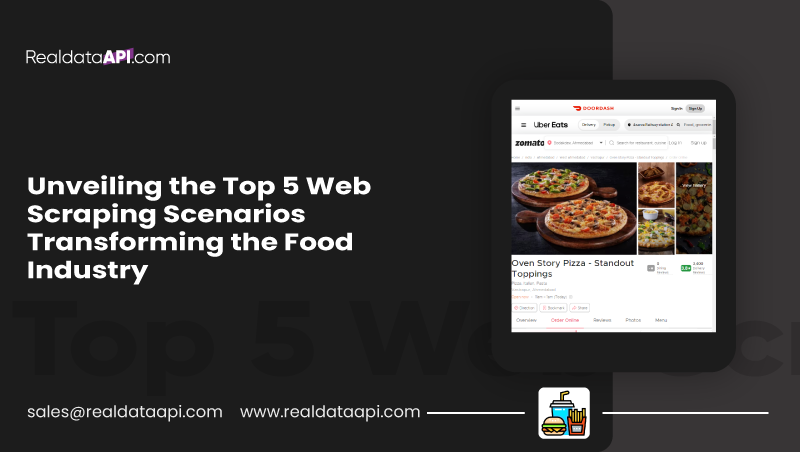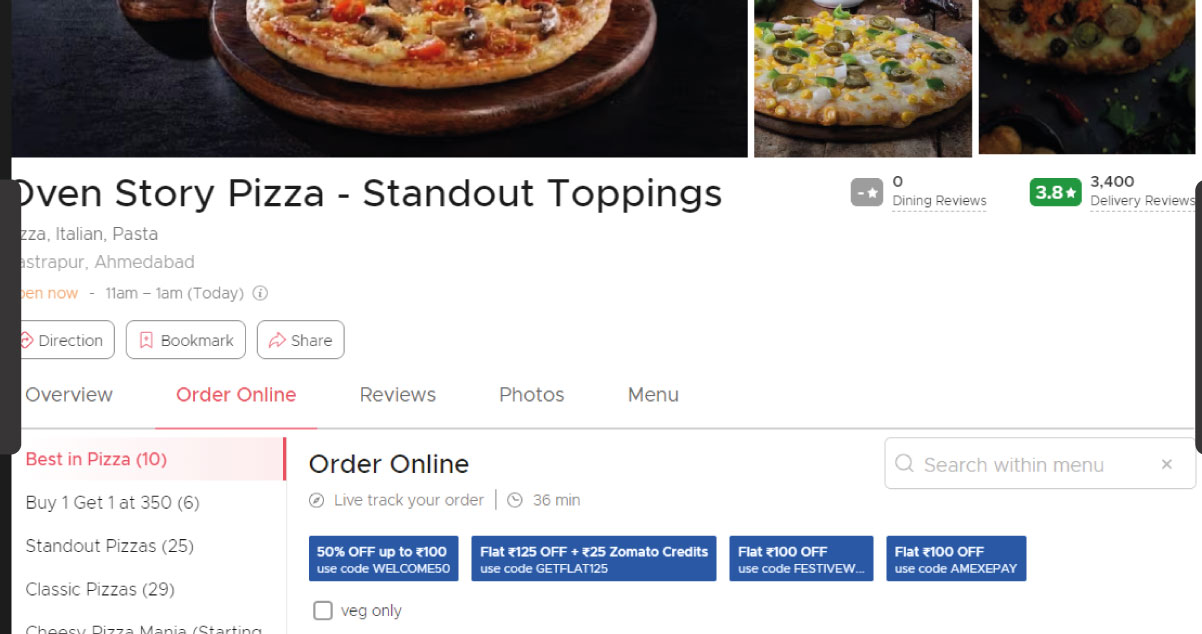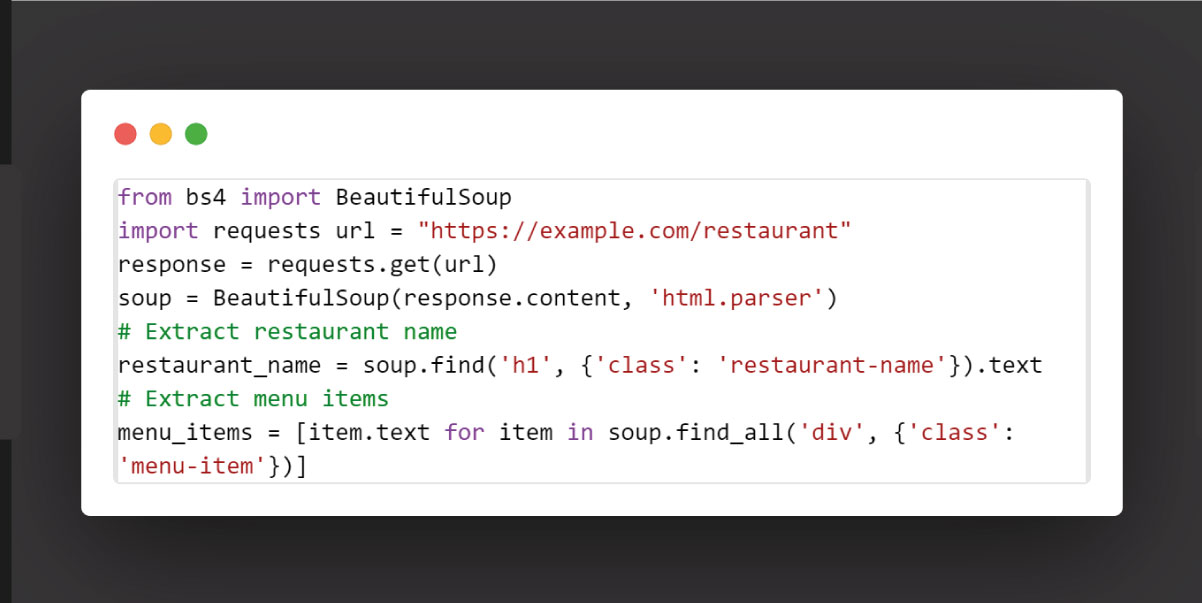

Introduction
In the dynamic landscape of the food industry, technological innovations are steering transformative changes, and web scraping scenarios are at the forefront of this evolution. This blog unveils the top five web scraping use cases that are reshaping the food industry's operations. From market analysis and price tracking to recipe curation and competitor monitoring, these scenarios offer invaluable insights for businesses seeking a competitive edge. Join us on a journey through the digital realms where data extraction and analysis converge to redefine how the food industry adapts, strategizes, and thrives in an era of unprecedented information accessibility.
What types of information can be obtained through web scraping from food delivery platforms?

Food ordering platforms contain a wealth of data that can be extracted for various purposes. Here are some types of data that can be obtained from these platforms:
Menu Information: Extract details about the items available on the menu, including names, descriptions, prices, and images.
User Reviews and Ratings: Gather customer reviews and ratings for different dishes and restaurants to understand customer preferences and sentiments.
Restaurant Information: Retrieve restaurant details, such as names, locations, contact information, opening hours, and cuisines offered.
Order History: Access information about past orders, including order IDs, items ordered, order status, and timestamps.
Delivery Information: Extract data related to the delivery process, including delivery times, delivery person details, and delivery status.
Promotions and Discounts: Capture details about ongoing promotions, discounts, and special offers to analyze marketing strategies.
Customer Profiles: Obtain user information, including usernames, email addresses, delivery addresses, and contact numbers.
Payment Information: Extract data on payment methods, transaction amounts, and payment confirmation details.
Geographical Data: Retrieve location-based data to understand popular dining areas, delivery zones, and regional food preferences.
Ingredient Information: Depending on the platform, you can extract details about the ingredients used in various dishes.
Trends and Popular Items: Identify trending dishes and popular items among users to gain insights into market demands.
Order Customization Data: Extract information about how users customize their orders, such as special instructions or modifications to menu items.
It's important to note that while web scraping can provide valuable data, it's crucial to comply with the terms of service of the respective platforms and adhere to legal and ethical considerations when extracting and using data. Additionally, the specific data available may vary across different food ordering platforms.
How to Extract Restaurant and Food Data?
Scraping food and restaurant data involves several steps. Here's a general guide on how to scrape such information from websites:
Identify the Target Website:
Determine the food ordering platform or restaurant websites you want to extract data from.
Understand Website Structure:
Analyze the website's structure, identifying the HTML elements containing the needed data, such as menus, reviews, and contact details.
Choose a Web Scraping Tool:
Select a web scraping tool or library. Python-based libraries like BeautifulSoup and Scrapy are commonly used for web scraping tasks. Other tools like Selenium can be employed for websites with dynamic content.
Inspect the Website's HTML:
Use browser developer tools to inspect the HTML structure of the pages you want to scrape. Identify the CSS selectors or XPath expressions for the relevant data.
Write Scraping Code:
Write a script in your chosen programming language to navigate through the website, send HTTP requests, and extract data using the identified selectors or XPath expressions.
Example using BeautifulSoup in Python:

Handle Pagination and Dynamic Content:
If the website has multiple pages or uses dynamic content loading, implement mechanisms to handle pagination or wait for dynamic elements to load before scraping.
Respect Robots.txt and Website Policies:
Check the website's robots.txt file to ensure compliance with scraping policies. Respect the website's terms of service and avoid aggressive scraping to prevent disruptions.
Data Storage:
Decide on a method for storing the scraped data. This could include saving data to a local file, a database, or a spreadsheet.
Handle Errors and Exceptions:
Implement error handling mechanisms to manage connection errors, timeouts, or website structure changes.
Test Responsibly:
Conduct small-scale tests before running your scraping script extensively to ensure it works as intended without violating website policies.
Remember that web scraping should be performed responsibly and ethically, respecting the privacy and terms of service of the websites you are scraping. Additionally, be aware that scraping may be subject to legal and ethical considerations depending on your location and the website's policies.
Top 5 use cases of web scraping food delivery data
It's important that while web scraping provides valuable insights, it should be performed responsibly and in compliance with the terms of service of the respective platforms. Additionally, businesses should be aware of legal and ethical considerations associated with data extraction and usage.
Market Analysis and Competitor Monitoring
Web scraping can gather data on the menus, prices, and promotions offered by various food delivery platforms and restaurants. This information is valuable for conducting market analysis, identifying trends, and monitoring competitors' strategies in the food delivery industry.
Dynamic Pricing Strategies
Businesses can implement dynamic pricing strategies by extracting real-time pricing data from food delivery platforms. This involves adjusting menu prices based on demand, time of day, and competitor pricing, optimizing revenue, and staying competitive in the market.
Customer Review and Sentiment Analysis
Web scraping allows businesses to extract customer reviews and ratings from food delivery platforms. Analyzing this data provides insights into customer sentiments, preferences, and areas for improvement. Businesses can use this information to enhance the quality of their services and offerings.
Menu Optimization and Trends Identification
Analyzing menu data through web scraping helps businesses identify popular dishes, trending cuisines, and customer preferences. This information is crucial for optimizing menus, introducing new items, and staying aligned with current food trends, thereby improving customer satisfaction.
Location-based Decision Making
Extracting geographical data, including popular delivery areas and customer locations, enables businesses to make informed decisions about service expansion, marketing strategies, and optimizing delivery routes. Understanding the regional preferences and demands aids in tailoring services to specific locations, enhancing overall operational efficiency.
Conclusion
The Real Data API stands as a transformative force in the realm of data accessibility, offering businesses an unprecedented gateway to real-time information. As a dynamic interface connecting applications with live data streams, it empowers organizations to make informed decisions with immediacy and accuracy. By harnessing the capabilities of the Real Data API, businesses can streamline their operations, gaining a competitive edge in an ever-evolving landscape.
This advanced API not only facilitates the retrieval of up-to-the-moment data but also enhances the efficiency of processes such as dynamic pricing, inventory management, and trend analysis. Its structured data delivery, often in formats like JSON, ensures seamless integration into diverse software environments. Moreover, the Real Data API aligns with compliance standards, promoting responsible data utilization and respecting the terms of service of the platforms it interacts with.
As industries increasingly prioritize real-time insights, the Real Data API emerges as an indispensable tool, catalyzing innovation and driving strategic decision-making. With its potential to revolutionize how businesses access and leverage data, the Real Data API beckons as a pivotal enabler of efficiency and competitiveness.
Explore the future of data-driven operations with the Real Data API – where insights unfold in real time. Act now and elevate your business with the immediacy of live data!













